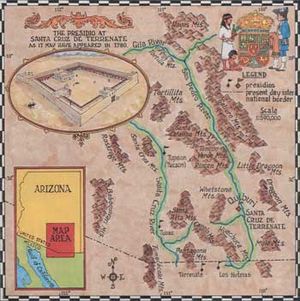Presidio Santa Cruz de Terrenate facts for kids
Quick facts for kids Presidio Santa Cruz de Terrenate |
|
|---|---|
| Cochise County, Arizona | |
 |
|
| Type | Army fortification |
| Site information | |
| Controlled by | |
| Site history | |
| Built | 1776 |
| Built by | |
| In use | 1776-1780, 1878 |
| Garrison information | |
| Past commanders |
|
| Occupants | |
The Presidio Santa Cruz de Terrenate was an old Spanish military fort, also called a presidio. It is located in Arizona, near the town of Tombstone. This fort was an important place long ago in the history of the United States.
History of the Spanish Fort
The Presidio Santa Cruz de Terrenate was built in 1775. It was placed on a hill overlooking the San Pedro River. An Irish-born Spanish Army Colonel named Hugo Oconór ordered its construction. He built it for King Charles III of Spain.
This fort is one of the best-preserved sites from a chain of similar forts. These forts stretched from Louisiana in the east to California in the west. Like other forts on the edge of the Spanish territory in North America, Santa Cruz de Terrenate was guarded by special soldiers. These soldiers were called soldados de cuera, meaning "leather-jacket soldiers."
Why the Fort Failed
The fort was never fully finished as planned. Many problems stopped its completion.
- The Apache people often attacked the fort.
- There was also greed and corruption among the leaders.
- The soldiers had low spirits and morale.
The fort faced many difficulties. There was not enough food grown nearby. Apache raids often stole the horses. Supply trains carrying goods were also attacked. These constant attacks on the fort led to its abandonment in 1780.
In 1878, the United States Army briefly used the fort. However, they left it later that same year.
Discoveries at the Site
In 1951, a person named Charles DiPeso dug up parts of the site. He was an archaeologist, someone who studies old human history by digging up artifacts and structures. DiPeso thought that the fort was built over an old Sobaipuri Indian village called Quiburi.
However, other historians and archaeologists disagreed. They believed the structures found were actually the living areas for the Spanish soldiers and their families. One reason for this idea is that Sobaipuri Indians did not live in adobe (mud-brick) walled buildings. Also, historical records do not show Quiburi being in this exact spot. Instead, the Sobaipuri settlement here was called Santa Cruz. This name was later used for the fort (Santa Cruz de Terrenate) and the nearby Santa Cruz River.
Recent Excavations
More recently, from 2007 to 2010, another archaeologist named Deni Seymour explored the site. She dug in areas that DiPeso had not investigated. She also looked again at some of the things DiPeso had found. She used special dating methods to figure out the age of the structures.
Her work showed that there was indeed a Sobaipuri site before the fort was built. But historical documents suggest it was not the village of Quiburi. She also found signs of even older groups of people. These included the prehistoric Hohokam and Archaic cultures.
Evidence of the Hohokam people includes pottery pieces. These were found on the surface and even in the adobe walls of the Spanish fort. Older tools and points from the Archaic period were also found. They were on the surface, in the adobe walls, and in the dirt inside the old buildings.

